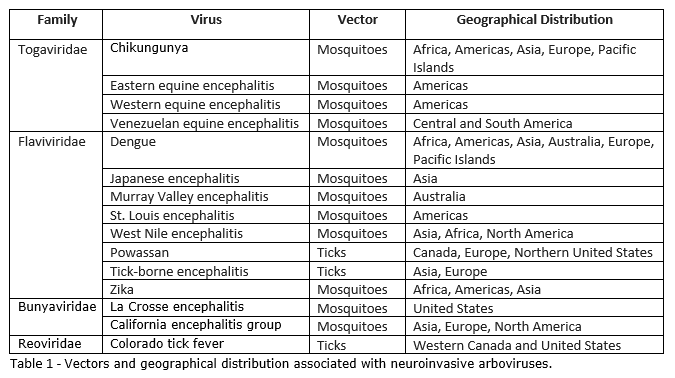[3]
Kuno G,Chang GJ, Biological transmission of arboviruses: reexamination of and new insights into components, mechanisms, and unique traits as well as their evolutionary trends. Clinical microbiology reviews. 2005 Oct;
[PubMed PMID: 16223950]
[4]
Salimi H,Cain MD,Klein RS, Encephalitic Arboviruses: Emergence, Clinical Presentation, and Neuropathogenesis. Neurotherapeutics : the journal of the American Society for Experimental NeuroTherapeutics. 2016 Jul;
[PubMed PMID: 27220616]
[5]
Caron M,Paupy C,Grard G,Becquart P,Mombo I,Nso BB,Kassa Kassa F,Nkoghe D,Leroy EM, Recent introduction and rapid dissemination of Chikungunya virus and Dengue virus serotype 2 associated with human and mosquito coinfections in Gabon, central Africa. Clinical infectious diseases : an official publication of the Infectious Diseases Society of America. 2012 Sep;
[PubMed PMID: 22670036]
[6]
Panning M,Grywna K,van Esbroeck M,Emmerich P,Drosten C, Chikungunya fever in travelers returning to Europe from the Indian Ocean region, 2006. Emerging infectious diseases. 2008 Mar;
[PubMed PMID: 18325256]
[7]
Gérardin P,Barau G,Michault A,Bintner M,Randrianaivo H,Choker G,Lenglet Y,Touret Y,Bouveret A,Grivard P,Le Roux K,Blanc S,Schuffenecker I,Couderc T,Arenzana-Seisdedos F,Lecuit M,Robillard PY, Multidisciplinary prospective study of mother-to-child chikungunya virus infections on the island of La Réunion. PLoS medicine. 2008 Mar 18;
[PubMed PMID: 18351797]
[8]
Gérardin P,Couderc T,Bintner M,Tournebize P,Renouil M,Lémant J,Boisson V,Borgherini G,Staikowsky F,Schramm F,Lecuit M,Michault A, Chikungunya virus-associated encephalitis: A cohort study on La Réunion Island, 2005-2009. Neurology. 2016 Jan 5;
[PubMed PMID: 26609145]
[9]
Eastern equine encephalitis--New Hampshire and Massachusetts, August-September 2005. MMWR. Morbidity and mortality weekly report. 2006 Jun 30;
[PubMed PMID: 16810146]
[10]
Johnson BW,Kosoy O,Martin DA,Noga AJ,Russell BJ,Johnson AA,Petersen LR, West Nile virus infection and serologic response among persons previously vaccinated against yellow fever and Japanese encephalitis viruses. Vector borne and zoonotic diseases (Larchmont, N.Y.). 2005 Summer;
[PubMed PMID: 16011430]
[11]
Calisher CH, Medically important arboviruses of the United States and Canada. Clinical microbiology reviews. 1994 Jan;
[PubMed PMID: 8118792]
[13]
Verma R,Sharma P,Garg RK,Atam V,Singh MK,Mehrotra HS, Neurological complications of dengue fever: Experience from a tertiary center of north India. Annals of Indian Academy of Neurology. 2011 Oct;
[PubMed PMID: 22346016]
[14]
Madi D,Achappa B,Ramapuram JT,Chowta N,Laxman M,Mahalingam S, Dengue encephalitis-A rare manifestation of dengue fever. Asian Pacific journal of tropical biomedicine. 2014 May;
[PubMed PMID: 25183150]
[15]
Carod-Artal FJ,Wichmann O,Farrar J,Gascón J, Neurological complications of dengue virus infection. The Lancet. Neurology. 2013 Sep;
[PubMed PMID: 23948177]
[16]
van den Hurk AF,Ritchie SA,Mackenzie JS, Ecology and geographical expansion of Japanese encephalitis virus. Annual review of entomology. 2009;
[PubMed PMID: 19067628]
[17]
Hills SL,Walter EB,Atmar RL,Fischer M, Japanese Encephalitis Vaccine: Recommendations of the Advisory Committee on Immunization Practices. MMWR. Recommendations and reports : Morbidity and mortality weekly report. Recommendations and reports. 2019 Jul 19;
[PubMed PMID: 31518342]
[18]
Selvey LA,Speers DJ,Smith DW, Long-term outcomes of Murray Valley encephalitis cases in Western Australia: what have we learnt? Internal medicine journal. 2016 Feb;
[PubMed PMID: 26601912]
Level 3 (low-level) evidence
[19]
Sejvar JJ,Bode AV,Curiel M,Marfin AA, Post-infectious encephalomyelitis associated with St. Louis encephalitis virus infection. Neurology. 2004 Nov 9;
[PubMed PMID: 15534266]
[20]
Romero JR,Simonsen KA, Powassan encephalitis and Colorado tick fever. Infectious disease clinics of North America. 2008 Sep;
[PubMed PMID: 18755390]
[22]
White MK,Wollebo HS,David Beckham J,Tyler KL,Khalili K, Zika virus: An emergent neuropathological agent. Annals of neurology. 2016 Oct;
[PubMed PMID: 27464346]
[23]
Burakoff A,Lehman J,Fischer M,Staples JE,Lindsey NP, West Nile Virus and Other Nationally Notifiable Arboviral Diseases - United States, 2016. MMWR. Morbidity and mortality weekly report. 2018 Jan 12;
[PubMed PMID: 29324725]
[24]
Garg S,Jampol LM, Systemic and intraocular manifestations of West Nile virus infection. Survey of ophthalmology. 2005 Jan-Feb;
[PubMed PMID: 15621074]
Level 3 (low-level) evidence
[26]
Ali M,Safriel Y,Sohi J,Llave A,Weathers S, West Nile virus infection: MR imaging findings in the nervous system. AJNR. American journal of neuroradiology. 2005 Feb;
[PubMed PMID: 15709126]
[27]
Rodriguez AJ,Westmoreland BF, Electroencephalographic characteristics of patients infected with west nile virus. Journal of clinical neurophysiology : official publication of the American Electroencephalographic Society. 2007 Oct;
[PubMed PMID: 17912061]
[28]
Klee AL,Maidin B,Edwin B,Poshni I,Mostashari F,Fine A,Layton M,Nash D, Long-term prognosis for clinical West Nile virus infection. Emerging infectious diseases. 2004 Aug;
[PubMed PMID: 15496241]
[29]
Haaland KY,Sadek J,Pergam S,Echevarria LA,Davis LE,Goade D,Harnar J,Nofchissey RA,Sewel CM,Ettestad P, Mental status after West Nile virus infection. Emerging infectious diseases. 2006 Aug;
[PubMed PMID: 16965710]
[30]
Carson PJ,Konewko P,Wold KS,Mariani P,Goli S,Bergloff P,Crosby RD, Long-term clinical and neuropsychological outcomes of West Nile virus infection. Clinical infectious diseases : an official publication of the Infectious Diseases Society of America. 2006 Sep 15;
[PubMed PMID: 16912946]
[31]
Loeb M,Hanna S,Nicolle L,Eyles J,Elliott S,Rathbone M,Drebot M,Neupane B,Fearon M,Mahony J, Prognosis after West Nile virus infection. Annals of internal medicine. 2008 Aug 19;
[PubMed PMID: 18711153]

